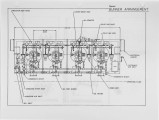| OCR Text |
Show cap drilled at a half angle of 45 degrees. The particle size distribution of the spray was specified to be typical of a #2 MV atomizing gun operating with .15 pounds steam/pound oil. Droplet volatility was specified at 100 percent, to simulate a completely evaporating fuel oil (flyash not accounted for). The model was set up for a throat stoichiometry of 95 percent of combustion air, with the remainder of the combustion air entering through the floor ports. TABLE 2 GAS PHASE BOUNDARY CONDITIONS BASE CASE PARAMETER VALUE COMBUSTION AIR Throat Stoichiometry .95 Total Excess Air 12 Percent Initial Throat Velocity (core/annulus) 20 fps/90 fps Port Velocity 50fps Initial Temperature 405 F FUEL Heat of Reaction 18,520 BTU/Pound Stoichiometric Ratio 3.2 Ib 02/lb Fuel Molecular Weight 72 Activation Energy 72,000 BTU/Pound- Mole A & B Mixing Constants 4&.5 CONVERGED BASE CASE FLOWFIELD Centerline velocity vectors for the converged Base Case flowfield are shown in Figure 5b. The vectors show the rapid velocity increase of the combusting gases at the throat exit and the resultant entrainment of tertiary air. Also depicted are two predominant recirculation zones; one in the lower corner of the furnace downstream of the floor ports, and the other in the front of the furnace above the quarl. Centerline contours of fuel and oxygen residual are shown in Figures 5c and 5d, with three dimensional profiles shown in Figures 5e and 5f respectively. Note the rapid rate of fuel burnout in areas of high oxygen concentrations, and the converse high concentration of fuel residual in areas of reduced oxygen concentrations. Although the results indicate an acceptable level of fuel residual burnout at the furnace exit, an obvious concern was the reducing environment in the recirculating zone above the burners: The NOx port combustion air stream had insufficient momentum to penetrate the exit throat gas stream, resulting in high fuel residual in the upper front region of the furnace. This led to the development of NOx port sensitivity cases, where methods of increasing tertiary air penetration above the quarl centerline were investigated. Summarized below are the results of the more successful sensitivity cases run. NOx PORT SENSITIVITY CASES INCREASED TERTIARY AIR VELOCITY: As a first step towards improving tertiary air penetration into the combusting throat gas stream, the momentum of the tertiary air was augmented via increased velocity. Based on available windbox pressure and calculated tertiary air duct and damper pressure losses, a maximum velocity of 150 feet-per-second was utilized, and the nozzle cross-sectional area was reduced accordingly to maintain consistent tertiary air flow. The resultant flowfield, displayed in Figures 6a thru 6c, shows a Significant improvement in tertiary air penetration along the port and quarl centerline, but does not display a corresponding reduction in fuel residual along the furnace exit. This may be best explained by observation of Figure 6b, which displays a cross-sectional view of Oxygen contours just downstream of the ports: As shown, the narrower tertiary air nozzles penetrate the combustion gases only along the centerline region, resulting in a somewhat nonuniform tertiary air distribution. |















